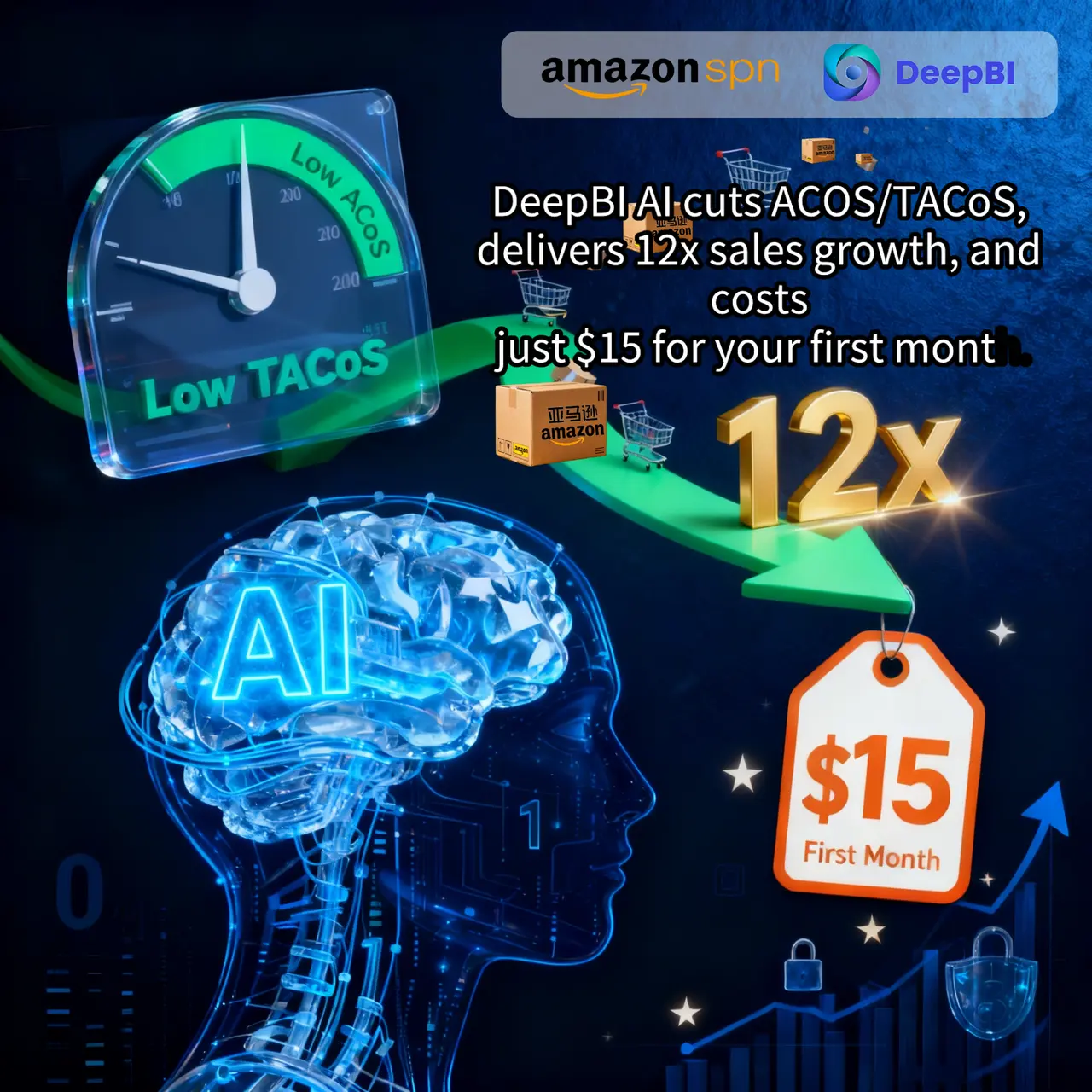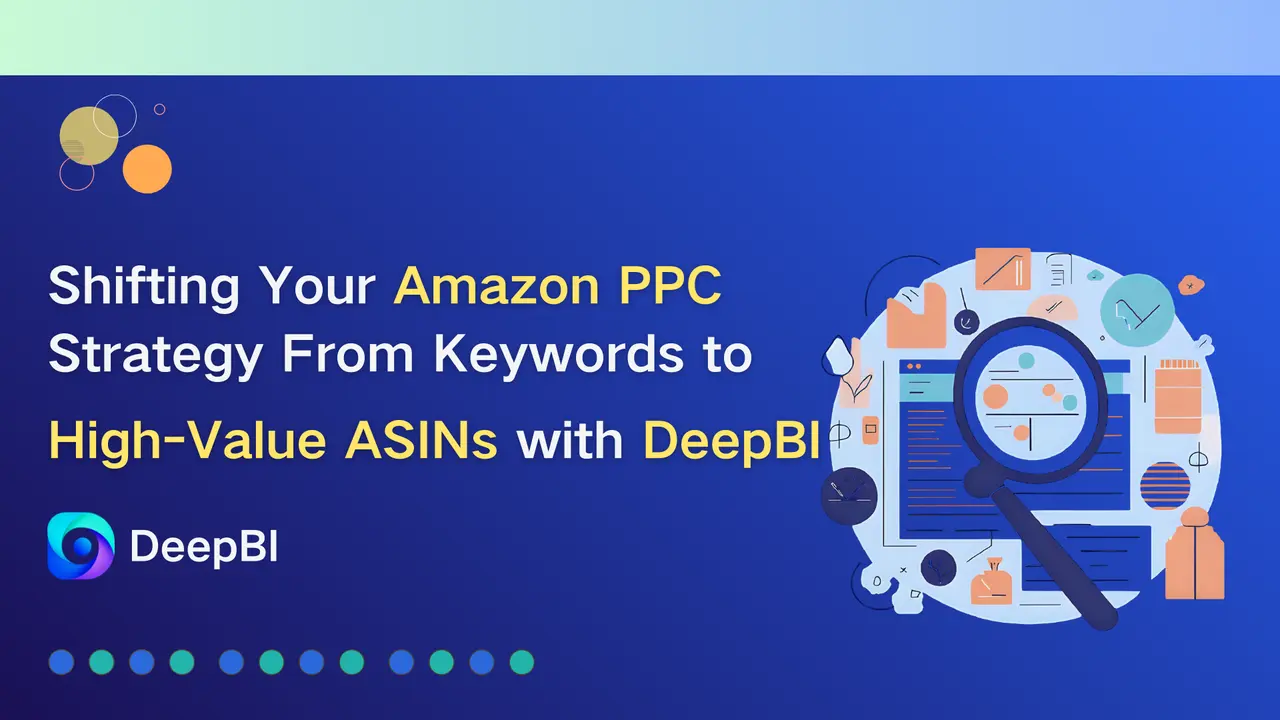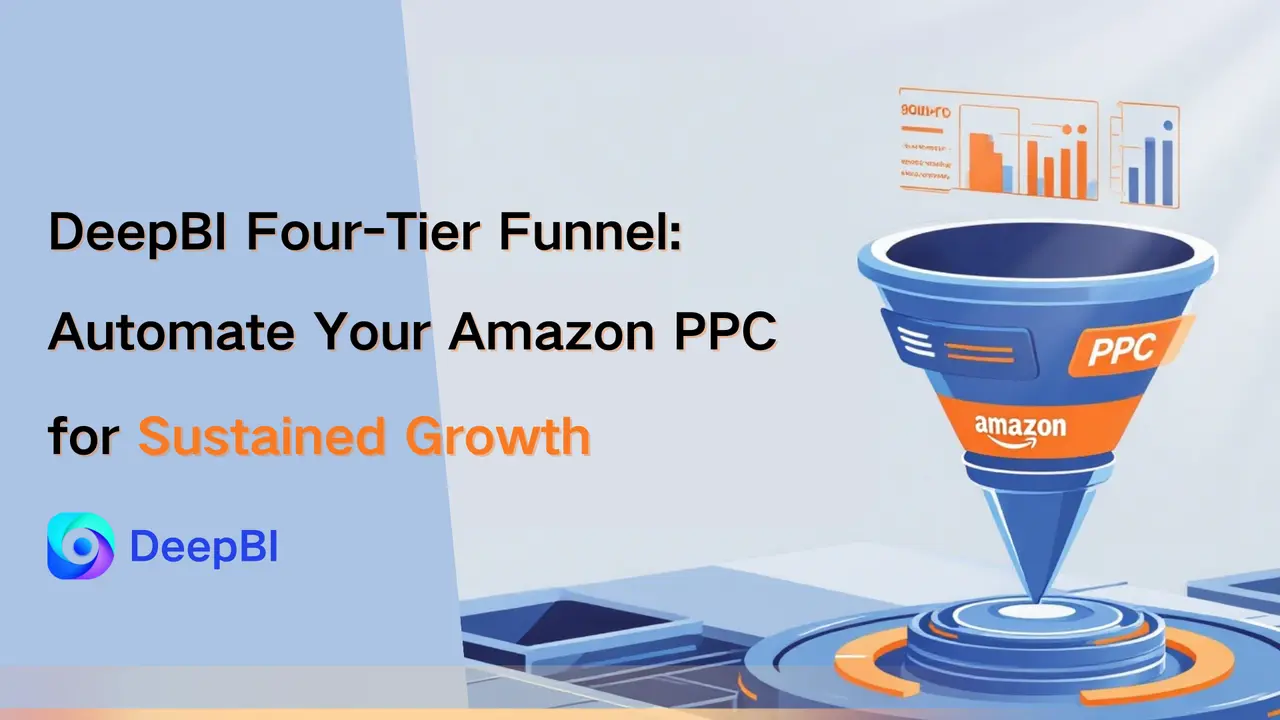The Reality Behind Every New Amazon Seller's Breaking Point
Sarah launched her first Amazon product one year ago—a sleek yoga mat she'd spent months perfecting. Within six months, she'd spend more time managing ads than she did creating the product. That's when she realized: Amazon PPC wasn't designed for beginners.
The listing looked great. Reviews started coming in. Everything seemed ready. Then came PPC.
Within months, she was spending 4-6 hours daily staring at Amazon's advertising dashboard. Monitoring campaigns regularly, adjusting bids, filtering keywords—the workload never stopped. Her notebook filled with scribbled keywords: "yoga mat," "exercise mat," "non-slip mat," "eco-friendly yoga mat," "thick yoga mat for beginners"... the list grew to 247 terms.
Which ones actually mattered? Which match type should each use? What bid makes sense? Beginners often get confused by broad, phrase, and exact match types, and Sarah was no exception.

The breaking point came when she tried scaling. Managing multiple products and listings is nearly impossible when you're learning advertising simultaneously. It's especially challenging if you have multiple ASINs to maintain and make profitable.
Sarah wasn't failing because she lacked ambition or work ethic. She was failing because Amazon PPC demands expertise that takes years to develop, and beginners simply don't have that time.
This is the expertise barrier. And it's crushing thousands of new sellers every month.
The Impossible Standard: What Amazon PPC Actually Demands

Let's be brutally honest about what effective Amazon advertising requires:
1. Keyword Intelligence Across Thousands of Terms

A single product might have 5,000-10,000 potentially relevant keyword combinations. Many sellers jump into PPC without doing thorough keyword research. They either target overly broad terms with high competition or niche terms with little search volume.
For a wireless earbud seller, this means understanding the difference between:
- "bluetooth earbuds" (170,000 monthly searches, $2.50 CPC, highly competitive)
- "wireless earbuds for small ears" (8,200 searches, $0.85 CPC, high intent)
- "true wireless earbuds noise canceling" (22,000 searches, $1.75 CPC, moderate competition)
The Knowledge Requirement: Understanding search volume, buyer intent, competition levels, and conversion probability for each term. Choosing relevant keywords helps reduce wasted ad spend. By focusing on high-converting terms, advertisers can get more sales at a lower cost, maximizing return on investment (ROI).
The Reality for Beginners: This analysis alone could take 20+ hours weekly—if you even know what metrics to analyze.
These aren't optional skills for "advanced" sellers. This is table-stakes knowledge Amazon expects from day one—whether you're a Fortune 500 brand or a first-time seller with one product.
2. Continuous Bid Optimization Across Multiple Variables
One of the biggest mistakes we see is when Amazon sellers make changes based on daily results. Since Amazon ad data is delayed by 48 to 72 hours, short-term fluctuations don't give you the full picture.
You need to:
- Track ACOS trends over 14-30 day windows
- Adjust bids based on conversion patterns, not just clicks
- Account for competitor bid changes (which happen hourly)
- Balance short-term efficiency with long-term organic ranking goals
The Knowledge Requirement: Statistical analysis skills, understanding of Amazon's attribution delays, and experience interpreting performance patterns.
The Reality for Beginners: Most make reactive decisions based on yesterday's data—leading to overcorrections that tank performance.
3. Multi-ASIN Campaign Architecture
Managing multiple seller accounts can be time-consuming, as you will need to monitor each account individually. Even within a single account, it's nearly impossible to be completely on top of your listings, especially if you have multiple ASINs to maintain and make profitable.
For a seller with just 5 products, this means:
- 15+ separate campaigns (Auto, Manual Exact, Manual Phrase for each)
- 100+ ad groups
- 500+ keywords to track individually
- Thousands of daily data points to interpret
The Knowledge Requirement: Campaign structure expertise, budget allocation strategy, and organizational systems to prevent chaos.
The Reality for Beginners: Many beginners create a single campaign for all their products, with a mishmash of keywords, leading to diluted performance and unclear data.
4. Negative Keyword Mastery
Analyzing Excel files and manually updating your PPC campaigns is incredibly time-consuming. Using bulk uploads is much faster, but there are errors at times that you need even more time to figure out and fix.
Negative keywords prevent your ads from showing for irrelevant searches. Miss this, and you bleed budget.
A "wireless charger" seller needs to exclude:
- "wireless charger case"
- "wireless charger stand"
- "cheap wireless charger"
- "DIY wireless charger" ...and hundreds more.
The Knowledge Requirement: Systematic search term analysis, understanding of phrase vs. exact negative matches, and ongoing monitoring.
The Reality for Beginners: Many sellers choose to keep high ACoS keywords, seeing it as a long-term investment, but without data to support this decision, they're guessing.
The Brutal Math: Why Manual Management Fails Beginners

Let's quantify what "managing Amazon PPC properly" actually means in time investment:
Daily Requirements:
- Download and analyze search term reports: 45 minutes
- Adjust underperforming keyword bids: 30 minutes
- Add negative keywords: 25 minutes
- Review campaign budgets and reallocate: 20 minutes
- Check competitor pricing and ad positions: 15 minutes
- Analyze ACOS by product/keyword: 30 minutes
Weekly Requirements:
- Deep keyword research for new opportunities: 2 hours
- Campaign structure optimization: 1.5 hours
- Competitor ASIN targeting analysis: 1 hour
- Performance reporting and strategy adjustment: 1 hour
Total Time Investment: 25-30 hours weekly
For someone simultaneously managing:
- Product sourcing and development
- Inventory management
- Customer service
- Listing optimization
- Supplier relationships
This is impossible.
Managing multiple seller accounts can be time-consuming, as you will need to monitor each account individually, fulfill orders, and respond to customer inquiries for each account.
If you're an SMB (small-mid business owner) with limited resources, these processes are even more challenging. The expertise barrier isn't just about what to do—it's about having the time to learn, implement, and refine strategies while running every other aspect of an Amazon business.

Enter DeepBI: Eliminating the Knowledge Barrier Entirely
Here's the paradigm shift: What if you didn't need to become a PPC expert at all?
DeepBI was designed specifically to solve the knowledge gap—not by teaching you advertising fundamentals, but by removing the need to learn them in the first place.
Automatic Keyword Discovery & Management: Your 24/7 Research Team
While traditional approaches require seed keywords are the foundation of your research. The first step is to identify these broad terms related to your product, DeepBI eliminates manual keyword research entirely.
How It Works:
Layer 1: Automated Exploration
The system simultaneously:
- Tests 1,000+ keyword variations through Auto campaigns
- Targets 500+ competitor ASINs to intercept proven buyer traffic
- Captures actual search terms from customer behavior
Remember Sarah's yoga mat? DeepBI automatically discovered:
- "yoga mat thick non slip" (high conversion, $0.65 CPC)
- "exercise mat for home gym women" (medium volume, 18% CVR)
- "eco friendly yoga mat natural rubber" (low competition, 22% CVR)
Without Sarah spending a single hour on research.
Layer 2: Intelligent Filtering
The keyword data you need will predominantly be in your Sponsored Products (SP) and Sponsored Brands (SB) campaigns. DeepBI analyzes this automatically, filtering within 3-7 days:
- Keywords with clicks but zero conversions → reduced bids or paused
- Keywords with ACOS above target → deprioritized
- Keywords with stable conversion → promoted to scaling
The Result: Only proven performers receive significant budget. DeepBI intelligently filters out underperforming traffic by combining historical advertising data with newly discovered high-converting keywords.
Dynamic Bid Optimization: Precision You Can't Match Manually
Always assess campaign performance over 14 or 30-day windows, as this gives you the clarity you need to scale or adjust without reacting to temporary shifts.
DeepBI's Advantage:
The system makes 250,000+ bid adjustments daily based on:
- 7-day performance trends (not 24-hour fluctuations)
- Conversion rate patterns by time of day
- Competitor bid changes (tracked in real-time)
- Inventory levels (reducing bids when stock is low)
Micro-Adjustments:
Instead of manual $0.10 changes, DeepBI adjusts in $0.01 increments—finding the exact bid that maximizes profit.
Example:
A "phone case" keyword converted at:
- $1.20 CPC → 5 sales, 28% ACOS
- $1.15 CPC → 4 sales, 26% ACOS
- $1.10 CPC → 2 sales, 24% ACOS
Manual management would miss the $1.15 sweet spot. DeepBI finds it automatically through progressive testing.
Multi-ASIN Management: Scaling Without the Chaos
As seller's gain momentum and add more products to their store, complexity multiplies.
DeepBI's Multi-Product Intelligence:
Simultaneous Campaign Creation:
For each ASIN, the system automatically creates:
- Auto campaigns for discovery
- Manual exact-match campaigns for proven keywords
- Competitor ASIN targeting campaigns
Smart Budget Distribution:
Instead of equal allocation, DeepBI flows budget to the highest-converting opportunities across all products simultaneously.
If Product A's keyword "X" has 15% CVR and Product B's keyword "Y" has 8% CVR, more budget automatically shifts to Product A—without you making a single manual adjustment.
Cross-Product Learning:
When a keyword works for one product, DeepBI tests related variations on similar products. A "waterproof phone case" success for iPhone 15 cases triggers automatic testing on iPhone 14 and Samsung cases.
Negative Keyword Automation: Stopping the Bleed
Keywords with low ACoS and high sales are the preferred keywords for PPC campaigns. However, negative keywords are the exact opposite. Identifying and tracking the keywords that have a high click-through rate, but zero to little sales, help cut down unwanted costs.
DeepBI's Protection System:
Automatic Negative Addition:
Search terms triggering clicks but zero conversions for 7+ days are automatically added as negative keywords.
For a "wireless mouse" seller, DeepBI blocked:
- "wireless mouse pad"
- "wireless mouse dongle"
- "how to connect wireless mouse"
Result: 18% reduction in wasted spend within the first month—without the seller reviewing a single search term report.
Real Results: Knowledge Gap Eliminated
Case Study: Sarah's Yoga Mat Journey (6-Month Head-to-Head Comparison)
Background:
- First-time Amazon seller
- Single product: premium yoga mat
- Started with manual campaign management
- Switched to split testing: Manual campaigns vs. DeepBI campaigns
- Testing period: March 2025 - August 2025
Sarah's Approach:
After struggling for months, Sarah decided to run a controlled experiment. She maintained her manual campaigns while simultaneously launching DeepBI campaigns for the same product. This allowed her to compare performance side-by-side.
Sales Trend (March–August 2025)
What happened:
- March–April: The manual campaigns started stronger because they already had data and history. DeepBI was still learning.
- May: DeepBI caught up and passed manual sales for the first time.
- June: DeepBI's sales jumped, while manual sales dropped sharply — the AI clearly started working better.
- July–August: DeepBI kept growing, manual campaigns kept falling. By August, DeepBI's sales were more than 3 times higher than manual.
Simple takeaway: Manual campaigns started ahead, but DeepBI learned fast and soon outperformed them completely.

Cost & ACOS (March–August 2025)
What happened:
- Early months: Manual campaigns cost more and wasted more money (higher ACOS). DeepBI spent less and was more efficient.
- Middle months: Manual campaigns became unprofitable — spending money but losing returns. DeepBI kept improving and stayed profitable.
- By August: Manual campaigns were almost shut down. DeepBI had its best ACOS (37%) and stable ad spend.
Simple takeaway: DeepBI not only sold more but also used ad money much smarter, keeping costs low and profits steady.

The Bottom Line: These graphs don't show failure vs. success. They show human limitations vs. AI capability. The knowledge gap is the difference between working in your business (manual campaigns) and working ON your business (strategic growth enabled by automation).
The Transformation in Numbers:
| Metric | Manual (6-Month Avg) | DeepBI (6-Month Avg) | Improvement |
|---|---|---|---|
| Average ACOS | 55% | 43% | 22% more efficient |
| Time on PPC | 25+ hrs/week | 2 hrs/week | 92% time saved |
| Keywords Optimized | 247 (manual) | 1,800+ (automated) | 7x coverage |
| Total Ad Spend | $6,750 | $7,200 | +7% more investment |
| Revenue Generated | $12,250 | $17,300 | +41% more sales |
| Return on Ad Spend | $1.81 per $1 | $2.40 per $1 | 33% better ROI |
What DeepBI Did Differently:
- Keyword Discovery: While Sarah manually tested 247 keywords, DeepBI automatically tested 1,847 variations and discovered 52 high-converting long-tail terms she never considered, including:
- "yoga mat thick non slip" (38% CVR)
- "exercise mat for home gym women" (22% CVR)
- "eco friendly yoga mat natural rubber" (28% CVR)
- Bid Optimization: DeepBI made 250,000+ micro-adjustments over 6 months vs. Sarah's weekly manual changes
- Negative Keywords: Automatically blocked 180+ wasteful search terms Sarah was still spending on
- Budget Efficiency: Concentrated spend on the top 18% of keywords that drove 76% of conversions
Sarah's Reflection:
"These graphs haunt me. Not because they show I failed—I was actually getting better every month. They haunt me because they show I was improving at 1x speed while DeepBI was improving at 10x speed.
Look at June. I hit 47% ACOS and thought I'd cracked the code. I was celebrating. Meanwhile, DeepBI hit 38% that same month and I didn't even notice because I was so focused on my 'personal best.'
By August, I was at 50% ACOS spending 4-6 hours daily. DeepBI was at 37% ACOS with 30 minutes of my time every few days. The knowledge gap wasn't about what I didn't know—it was about what I CAN'T know. No human can process the data patterns these graphs represent.
The 1,050 hours I got back? That's what built my yoga blocks line. The knowledge gap wasn't just costing me efficiency points. It was costing me my next product, my next revenue stream, my next level of business."
Most Importantly:
With DeepBI handling her campaigns, Sarah used her reclaimed time to:
- Launching 2 new products
- Improving product photography
- Building customer relationships
This is the power of eliminating the knowledge gap—not just better performance, but time reclaimed for actually growing your business.
The Five Ways DeepBI Makes Expertise Irrelevant
1. Zero Learning Curve Required
Traditional approach: Spend 3-6 months learning PPC fundamentals through courses, forums, and expensive mistakes.
DeepBI approach: Connect your account. Set your target ACOS. Launch.
The system immediately applies strategies that would take years to master.
2. Continuous Expert-Level Decisions
While it's a good base analysis, you may lose out on some good keywords this way too. Many of the best keywords have very high CPC, which makes the ad spend & ACoS high.
DeepBI knows when high CPC is justified (strong conversion) vs. wasteful (low intent)—a nuance beginners miss consistently.
3. Scales Effortlessly
If a seller does not have enough time to monitor each storefront or makes poor decisions, they risk accruing losses. Furthermore, dividing their attention between multiple seller accounts can have a negative impact.
DeepBI manages 1 ASIN or 100 ASINs with identical precision. The AI doesn't get overwhelmed.
4. Eliminates Emotional Decision-Making
Beginners often:
- Panic over a bad day and slash budgets
- Get excited about a good day and overspend
- Keep underperforming keywords due to sunk cost fallacy
DeepBI operates on data alone—removing the emotional pitfalls that tank beginner campaigns.
5. Organic Ranking Synergy
Your ad spend will directly impact organic ranking, so the real measure of PPC effectiveness is the total advertising cost of sale.
DeepBI's fifth layer strategically targets keywords to improve organic rankings—turning paid traffic into long-term free visibility. This sophisticated strategy requires deep platform knowledge that beginners lack.
Your Two Paths Forward
Path 1: Close the Knowledge Gap Yourself
- Invest 200+ hours learning PPC fundamentals
- Spend $3,000-5,000 on trial-and-error mistakes
- Dedicate 25+ hours weekly to campaign management
- Hope you make the right decisions as the platform evolves
Timeline to proficiency: 12-18 months
Opportunity cost: Every product you didn't launch, every customer relationship you didn't build, every hour spent in spreadsheets instead of growing your business.
Path 2: Let DeepBI Eliminate the Gap
- Connect your account (5 minutes)
- Set your goals (5 minutes)
- Focus on product development, customer service, and scaling
Timeline to results: 10-30 days
Time investment ongoing: 2-4 hours weekly for strategic oversight
Addressing Beginner Concerns
"Won't AI campaigns compete with manual campaigns I'm already running?"
DeepBI is designed to complement, not conflict. The system focuses on:
- Long-tail keywords your manual campaigns likely miss
- Competitor ASINs providing different traffic sources
- Emerging trends the AI detects before they become obvious
Overlap between AI and manual campaigns typically stays below 8%, compared to 23% industry average for uncoordinated efforts. You maintain control of core brand terms while AI expands your reach.
"What if my budget runs out too fast?"
The AI includes multiple safeguards:
- Progressive bid increases in small increments ($0.01-0.03) rather than aggressive jumps
- ACOS circuit breakers that reduce spend immediately when targets are exceeded
- Daily budget caps you can set, with automatic distribution across campaigns
If a campaign spends $50 in one day but generates $200 in sales at 25% ACOS (within your target), that's efficient spending—not waste. The system distinguishes between fast efficient spending and fast wasteful spending.
"How do I know it's working?"
DeepBI provides transparent reporting showing:
- ACOS trends compared to your target
- Conversion rates for keywords and ASINs
- Sales attribution distinguishing AI-driven revenue from manual campaigns
- Budget efficiency metrics showing spend vs. return
You don't need to interpret complex data—the dashboard highlights what matters. If something needs attention, the system flags it clearly.
The Knowledge Gap Is Not Your Fault—But It's Your Choice
Amazon PPC complexity isn't a bug—it's a feature. The platform wants sophisticated advertisers because they drive revenue.
But that sophistication shouldn't be a barrier for beginners with great products and limited time.
By now, you should have a better understanding of the common obstacles new Amazon sellers face. The knowledge gap is real, it's massive, and it's why as we saw earlier, not all sellers are capitalizing on this opportunity equally.
DeepBI exists to level that playing field.
You don't need to become an advertising expert. You need an advertising expert working for you—24/7, making 250,000 daily decisions, learning from millions of data points, and optimizing with precision no human could match.
That's exactly what DeepBI delivers.
Getting Started: Three Simple Steps

Step 1: Connect Your Amazon Account
DeepBI integrates through Amazon's Service Provider Network (SPN), ensuring secure, compliant access to your advertising data. Connection takes minutes.
Step 2: Set Your Target ACOS
Based on your profit margins, define your acceptable ACOS (most new sellers start at 25-35%). This becomes the guardrail for all AI decisions.
Step 3: Select Products and Launch
Choose which ASINs to advertise. The system immediately creates optimized campaigns across Auto, Manual, and ASIN targeting—beginning the exploration phase.
That's it. The AI takes over from here.
The Difference Between Good Tools and Great Partnerships
Many advertising tools claim to "help" with Amazon PPC. The difference with DeepBI is philosophical: we don't just give you better dashboards—we take the work off your hands entirely.
For beginners, this distinction is critical. You don't need another tool to learn. You need a partner that already knows what to do.
DeepBI embodies this through:
- No setup complexity – Works immediately after connection
- No ongoing management – Daily optimizations happen automatically
- No advertising expertise required – AI makes expert-level decisions
- Measurable outcomes – Results appear in 10-30 days, not months
This allows you to focus on what actually matters when starting your Amazon business: sourcing great products, creating compelling listings, and delivering excellent customer experiences. The advertising complexity that stops most beginners becomes invisible.
The Bottom Line
Running an Amazon PPC campaign without proper keyword research is like shooting in the dark—there's no guarantee the ads will reach the right shoppers.
But here's what traditional advice won't tell you: proper keyword research takes expertise most beginners will never develop before their business fails.
The learning curve isn't something to be ashamed of—it's Amazon's reality. The platform has grown too complex, too competitive, and too demanding for part-time sellers to master alongside everything else required to succeed.
DeepBI doesn't close that gap. It makes it irrelevant.
Your competition is already using AI. The only question: Will you eliminate your expertise barrier today, or keep struggling with skills you don't have time to learn?
Stop fighting the learning curve. Start leveraging AI that already has the knowledge.
Get Started: Reclaim Your Time, Keep Your Profits
The expertise barrier is crushing thousands of beginners right now. They're working harder, sleeping less, and watching their ad spend disappear into campaigns they don't fully understand.
You don't have to be one of them.
Here's What Happens Next:
Step 1: Schedule a free consultation with our team
We'll review your current campaigns (if any), discuss your products, and show you exactly how DeepBI would approach your advertising—with zero commitment.
Step 2: See your personalized strategy
We'll create a sample optimization plan for your ASINs, showing predicted ACOS improvements and time savings.
Step 3: Launch with confidence
Connect your account, set your goals, and watch AI-powered advertising work while you focus on building your business.
Your Next Step
If you're a new Amazon seller struggling with PPC—or hesitant to start because it seems overwhelming—DeepBI offers a clear path forward. You gain access to AI-powered advertising that would cost tens of thousands to develop internally, packaged in a system designed for sellers just like you.
The question isn't whether you can afford AI advertising management. It's whether you can afford to compete without it.
Amazon's marketplace grows more competitive daily. Sellers who leverage AI tools gain an immediate efficiency advantage—lower costs, better targeting, and more time to focus on growth. Those who don't fall further behind.
Ready to see how AI-powered advertising can transform your Amazon business?
Get Started Today
📧 Email us: support@deepbi.com
💬 WhatsApp: +1 (617) 888-1931
🌐 Visit: www.deepbi.com
Schedule a free consultation to discuss your specific products and goals. We'll provide a personalized review showing exactly how DeepBI would approach advertising your ASINs—no commitment required.
Your competition is already using AI. The only question is: will you join them, or fall behind?
DeepBI – AI-Powered Amazon Advertising for Sellers Who Want to Grow, Not Guess





